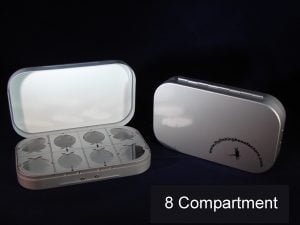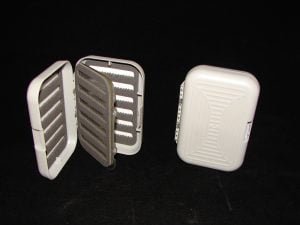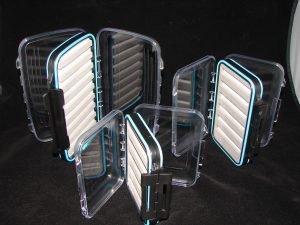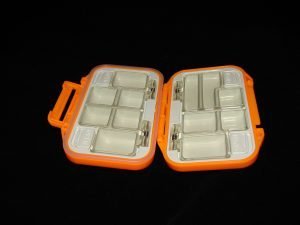Not concealed weapons, but something infinitely more important and precious – hot flies! Just as a pistol requires a unique size holster, different flies require storage containers with specific characteristics as well as an overall organization strategy. As a new fly angler, you undoubtedly fell victim to the subtle marketing associated with the sparkling display of hundreds of flies pristinely organized in an expansive exhibit designed to encourage high volume purchases. Now, where you put ‘em all?
The guidance on what type of fly goes in what type of box is relatively simple. Avoid putting dry flies in a small box that would crush the hackle. For dries, it is crucial the hackle remain precisely as it was tied to provide maximum buoyancy. Streamers tend to be large and require a box with enough room to hold the entire fly without the tail protruding over the edge and being crushed when the box is closed. Since nymphs are small and compact, they can go pretty much anywhere. With this in mind, a fly box with roomy compartments is the best approach for a dry fly. Foam is best for streamers while leaf boxes can store massive numbers of nymphs.

This box has spacious compartments to hold dry flies without compressing the hackle. Put nymphs in the foam
When buying a partitioned box, look for one with compartments that are easy to open yet close firmly. Avoid any box lacking individual lids over each section unless it is magnetic. In other words, don’t grab one of the lure boxes you used for spin fishing and fill it with flies because sooner or later, you will trip and watch in horror as those expensive flies trace an arc through the air and disappear in the wind or water. Even if sure-footed, a sudden, sadistic breeze may lift every fly from the box with similar results. This is the same reason you do not want to use the small boxes the fly shop provides to hold flies as you make selections from the display on the water. Transfer those flies to a real box.
It is hard to go wrong with a foam box if it provides enough open area between the foam and lid to keep the flies from touching. Dry flies can go in a foam box if there is plenty of room for them to spread out.

Perfect for holding numerous nymphs, swinging leaf boxes provide efficient storage. This box is too small for most streamers or dry flies.
Before putting flies in boxes, give some thought to streamside organization. Typically, you will have far more flies than you can comfortably carry or should take. How many boxes? That depends upon organization strategy. There are four basic choices:
- Organize by destination/month
- Organize by fly type
- Organize by family
- Stuff and go
Destination: Use a hatch chart to determine the flies to take. For example, there is no need to have a box full of terrestrial patterns in the middle of winter or a bunch of bass poppers on a trout stream. Obtain a hatch chart from a local fly shop or search the Internet and only take the patterns applicable to the timeframe when you will be fishing. If dry flies are in the mix, be sure the box has the space for them. When following this approach, you only need one box – the compartmented box is perfect (nymphs or small streamers in foam, dries and larger streamers in compartments).

These swingleaf keepers come in different sizes to accommodate any type of fly. The transparent cover allows you to see the contents.
Fly Type: Use one box each for streamers and nymphs. Dry flies and terrestrials can go in the same box.
Family: This is a two-box approach using foam boxes. Populate the first box with flies representing different lifecycle stages of the insects – nymph, emerger, cripple, and dry. Take at least three different sizes of each stage for maximum flexibility in matching the hatch. The second holds streamers and any oddball flies that just look too good to leave home. While streamers are not insects, always have a few sizes in different colors to mimic small prey.
Stuff and go: No desire or patience for organization? Heck, just stuff ‘em in a box and go fishing!
With the right flies in the right box, the final challenge is not to lose them on the stream. The best rule is to never place the box on the ground. Keep it in your hands, grab the fly, and immediately put the box away. For those whose mind might wander in excited anticipation of the next cast, consider using a zinger and velcro.
Just sew a strip of velcro to the inside of the pocket. Epoxy the opposing strip to the back of a small zinger and epoxy the zinger tab to the fly box. Can’t sew? Don’t use adhesive backed velcro since it will not last. Instead, cut two small holes in the back of the pocket (apply fabric tape first to stiffen/strengthen if you are willing to iron), thread string or a small cable tie through and tie the ends; forming a loop for the zinger.

Your eyes will cross putting tiny midges on foam. Use a specialty box with small compartments .
To use, attach the zinger to the pocket velcro or loop. When pulling the box out of the pocket, the zinger extends, and the box is always secure. Believe me, after absentmindedly losing several boxes of flies, the “put it back in the pocket” habit is critical for financial security! One more thing…. write your name and phone number on the box. If all else fails, maybe some kind soul will find the box bobbing in the water and get it back to you!
Ma
